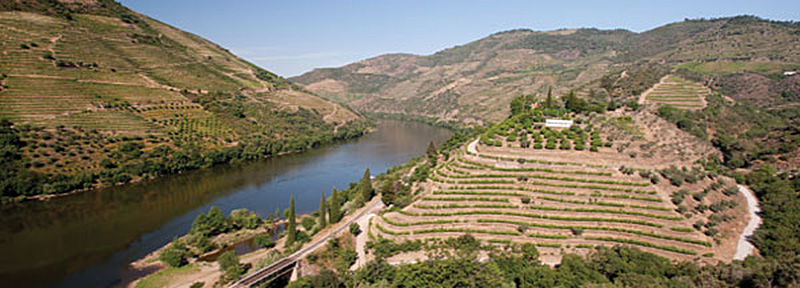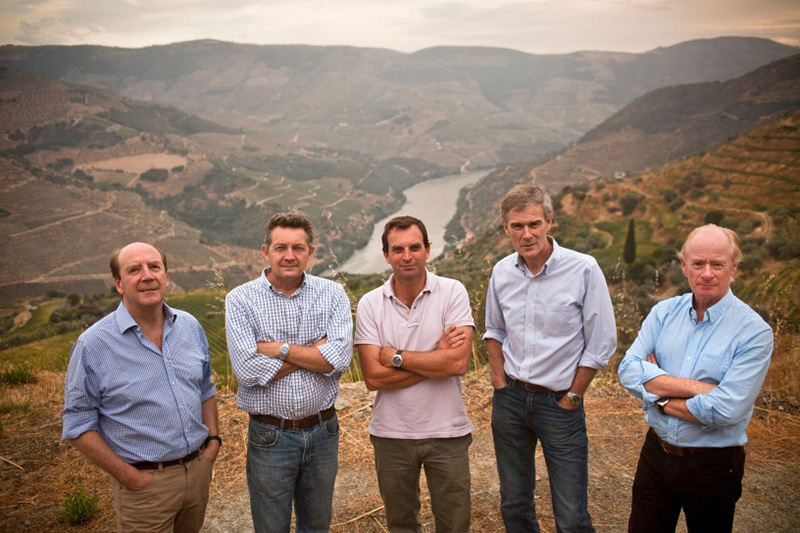
True Ports hail from the Douro valley in northern Portugal, and have done so for over three hundred years. The region’s predominant soil is schist, composed of various medium-grained to coarse-grained metamorphic rocks with laminated, often flaky parallel layers of micaceous minerals. The low annual rainfall makes this probably one of the driest regions of the world where grapes are grown without irrigation. This terroir results in very low-yielding vineyards, with vines bearing only a very few small bunches of full-flavored grapes whose thick skins protect them from dehydration.
Port is a fortified wine. Fortification is the addition of brandy or a neutral spirit to wine in order to boost the alcohol content. Fortified wines are often sweet, because the alcohol kills the yeast before fermentation completely runs its course, leaving residual sugar. This accounts for Port’s characteristic rich, luscious style and also contributes to the wine’s considerable ageing potential. Fortification also stabilizes the wine, a definite benefit for a product destined for the long sea voyage from Portugal to England, the first large market for it.
In 1798 Bruno da Silva, a Portuguese merchant from Oporto, traveled to London, where he imported wine from his native country, reversing the route of English traders to Portugal. He married an Englishwoman, was rapidly assimilated into London society, and built a reputation for his wines. When the outbreak of the Napoleonic wars in 1803 put his business in jeopardy, da Silva applied for ‘Letters of Marque’ (a Royal Assent to equip a merchant ship with guns) to secure safe passage of his Port from Oporto to England. His became the only Port company to transport its wines in its own armed fleet, a distinct competitive advantage.
Upon his death, the business passed to da Silva’s son John, who in 1862 partnered with Frederick William Cosens. Together with John’s son, Edward, the trio became the active partners in Silva & Cosens. Like his grandfather, Edward da Silva was also a shrewd businessman, and the company continued to prosper. Edward became a highly respected figure in the London wine trade, and was one of the founders of the Wine Trade Benevolent Society, (renamed The Drinks Trust in 2020) the leading British wine trade charity.
George Acheson Warre, whose well-known family had been involved in the Port trade since its earliest years, joined Silva & Cosens as partner in 1868. In 1877, the firm merged with another leading Port company, Dow & Co, whose senior partner was James Ramsay Dow. Although smaller than Silva & Cosens, Dow & Co had become a very highly regarded Port producer with a particularly fine reputation for its vintage Ports, and when the two companies merged, it was decided to adopt Dow’s as the brand name.
The Vineyards

The Douro
Quinta do Bomfim has provided the main source for Dow’s products since it was acquired in 1896. The property is a classic ‘river quinta (estate)’ with many natural advantages: it is south-facing, ensuring ample exposure to the sun; its stony schist soil affords excellent drainage, allowing water to reach the vines’ deep roots; the annual rainfall is near perfect at 31 inches (15 year annual average); the altitude ranges from 394 to 1,115 feet above sea level, accommodating both gentle gradients lower down and progressively steeper slopes higher up the valley side. A further advantage is the consistent climate.
The principal grape varieties planted are: Touriga Franca, Touriga Nacional, Tinta Barroca, Tinta Roriz and old mixed vines. Two-thirds of the vineyard is now over 20 years old, while one third is between 30 to 40 years old.
Another classic river quinta, Senhora da Ribeira is located 15 miles upriver from Quinta do Bomfim. Senhora da Ribeira is set in the remote, hot, and dry Douro Superior and commands a north bank position, overlooking a broad sweep of the Douro. The quinta was built close to an ancient and strategic river crossing, guarded by two 12th century hilltop castles on either side of the Douro. Travelers would pause here to pray for a safe river passage and onward journey at a small chapel dedicated to the ‘Lady of the River’ (literally: Senhora da Ribeira).
The quinta’s high proportion of old vines (45% are over 25 years old) is of critical importance. The old vines are very low-yielding, producing on average less than two pounds of grapes each, giving intense and concentrated musts. As with Bomfim, the consistency of the climate plays a key role, although the rainfall is only about half of that experienced at Bomfim: 18 inches is the 10 year average.
The Symingtons
Andrew James Symington, a Scotsman, travelled to Oporto in 1882 at the age of 18 to work for the Grahams (if you are familiar with Ports, you should be spotting a trend here), another Scottish family long established in Portugal. Young and ambitious, he soon left to work on his own in the Port trade, where he gradually built up a reputation as an expert taster. By 1905 he had become a partner in Warre & Co, the first British Port company established in Portugal, and in a few years he became the company’s sole owner.
Curiously, at this time the Warre family, who were the principal owners of Dow’s, had no remaining interest in the company that bore its name. In 1912, Dow’s senior partner, George A. Warre decided to return to England and invited Symington to manage the Douro Valley vineyards of Dow, its lodges (wineries) and assets in Gaia. In the same year, a share swap took place whereby Symington took a 30% stake in Dow’s and Warre took, in return, shares in Warre & Co. The successful partnership between the Symingtons as Port producers in the Douro and Gaia and the Warre’s in London looking after sales lasted for half a century until 1961 when the Symingtons finally became the sole owners of Dow’s.
With their extensive vineyard holdings and Port brands, including Dow’s, Grahams, Warre’s, and Cockburn’s, the Symingtons are often described as ruling over a “Port empire.” In addition to their Port holdings, Symington owns several brands of Douro DOC wines.

Dow’s Late Bottled Vintage Port 2016
The Portugese only declare Port vintages in years which they deem worthy. In the 21st century, these have been 2003, 2007, 2011, 2014, 2015, 2016, 2017, and 2018, a rather more frequent pace than in the 20th century. These “Vintage Ports” are the top-tier offerings. “Late Bottled Vintage Ports” are made from grapes of a single vintage, in this case 2016, but of second-tier quality fruit, although they can still be quite good.
As indeed this one is. This wine spent four to six years in oak, as all Late Vintage Ports do. Dark purple in color, it offers subtle aromas of raisin, prune, and baking spice. The rich mouthfeel carries flavors of ripe berries, particularly blackberry, and chocolate, and a well-balanced and restrained sweetness.
Pour this wine in a wine glass at room temperature, or slightly chilled in warm weather to make it more refreshing. It works as both an aperitif and after-dinner drink. It does not need to be decanted, is ready to drink on release, and should be consumed within four to six weeks of opening. The ABV is: 20%.
I have also recently reviewed another widely-available and similarly-priced Port from the Symington portfolio, Cockburn’s Special Reserve. While I enjoyed both, my nod goes to the Dow’s, with its less peppery, more balanced classic Port character.
Back to blog posts: https://winervana.com/blog/
